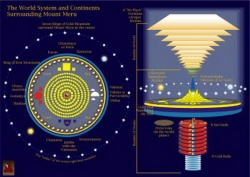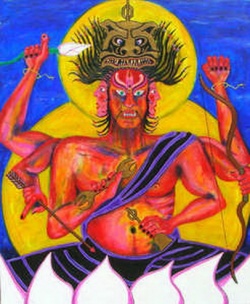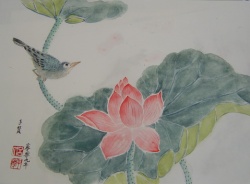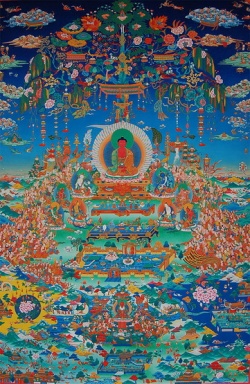Aizen
The wisdom king Craving-Filled (Aizen-myo'o). The Japanese god of love, worshipped by prostitutes, landlords, singers and musicians. Despite his ferocious appearance (he has a third eye vertically placed between his two other eyes and a lion's head in his hair) he is considered to be beneficent to mankind. Originally he was a god of the Shingon and Tendai and represented love that changes into desiring 'enlightenment'.
Japanese mythology is a tangled knot of Buddhism and Shintoism, so that it is not always clear whether a particular deity is from Shinto or Buddhist. Buddhism spread into Japan around the 6th century CE and it quickly establish itself as a complement to Shintoism. Due to this overlap, Japanese religion and mythology had its own distinct flavour.
Aizen Myoo is one of the most popular deities in the Japanese pantheon. He is the god of love, a deity of both physical and intellectual desire and represents love transformed through the desire for enlightenment. The translation of his name reads “King of Esoteric Knowledge [called] Tinted by Love (or: Lust)".
Unlike many deities, Aizen Myoo is not an ancient deity taken over from the Indian pantheon, Buddhist or Hindu, into the vast crowd of East Asian Mikkyo divinities. The roots of this particular deity have no connection in India, Buddhism or in Tibet. It is under question whether Aizen Myoo has roots in Tang China instead. According to the Mikkyo ideology, Aizen also should not be regarded as an isolated single deity, but as a “manifestation (hen) or transformation (keshin) of another figure of the pantheon situated as the so-called Fundamental Aspect (honji)in a ‘higher’ position”.
In art, Aizen Myoo was commonly depicted in a frightening appearance; sculptures of the deity were generally painted him red, as red is the primarily colour which expresses emotion or excitement; it is the tint of blood which rushes into the veins and gives the face a hue of joy and happiness. A quote from the Kakuzen-sho states, “Just as with a mother who is overwhelmed by compassion for her only child, so blood is flowing out of all pores in the skin [of Aizen and tints his body red”.
In addition to this, the famous monk Ichijo (884 – 947 CE) stated that Aizen Myoo’s original colour was white. “Aizen-o is actually of white colour. But since he has compassion for the living beings and, since his spirit of compassion breaks through the structure of his bones so that tears of compassion flow through his whole body, his skin is tinted and he becomes red”.
Within art, the god is usually shown with a ’blazing circle’ that envelops his halo and the upper part of the lotus seat which he sits upon. This ‘blazing circle’ is commonly known as the Moon Disk, and is usually believed to represent the burning disk of the sun (nichirin) although there are some sources which state it is the moon (gachirin).
Aizen Myoo is usually depicted as having three eyes. In Buddhist iconography, three eyes are the typical paraphernalia of protective and fierce deities, with the third eye sitting vertically in the middle of the forehead. Additionally, the three eyes symbolise the Three Virtues (santoku) of the Absolute Body (hosshin) together with Transcendental Wisdom (hannya) and Liberation (gedatsu).
His eyes are usually described as fierce, but his seemingly wrathful look is, in reality, the apex of his compassion to help mankind overcome their difficulties on their way to salvation. It is here that one of the basic Buddhist conceptions, the interchangeability of opposites, can be seen in this deity.
The god’s hair is usually standing on end, emphasising his frightful appearance. This style of hair is characteristic of wrathful deities. With his hair in this style, it looks as though the deity had been shocked with an electric charge and is symbolic of his ecstatic emotion.
Like with many Tantric deities, Aizen Myoo has several arms in his main form. The main arms in front hold a bell and Vajra and are symbolic of the Appeasing Rites (sokusai-ho). The second pair grasping bow and arrow aptly symbolizes the Subduing Rites (keiai-ho) over which Aizen presides as Master. The third and upper pair, holding "that" and brandishing a lotus flower, hints at the exorcistic Terrible Rites (gobuku-ho).The bell is the symbol for stimulation, used to awaken the living beings from their sleep-like unawareness and to stimulate the Mind of Enlightenment (bodaishin) enclosed in a dormant position within each living being.
It is unclear to when in history Aizen Myoo materialized into a singular deity or even where he emerged from. The dating of the Yugi-kyo, our main source for his rituals and iconographic details, is still under debate. It is believed that Aizen Myoo had materialised in and around the 9th century CE, since the priest Kukai (774 – 835 CE) returned from China to Japan with a copy of Yugi-kyo.
In spite of Kukai bringing home the Yugi-kyo, no early Chinese sculptures or painting depict Aizen Myoo, even among the many Tang bronzes. It has been suggested by scholars the Aizen Myoo emerged from Chinese priests in the late 8th century from a composition of such deities as Ragaraja, Takki-raja or 'Dod-rgyal dmar-po from the lower strata of the Buddhist religion, since no direct or indirect counterpart can be found in either Indian or Tibetan Buddhism.
See; Craving-Filled.



